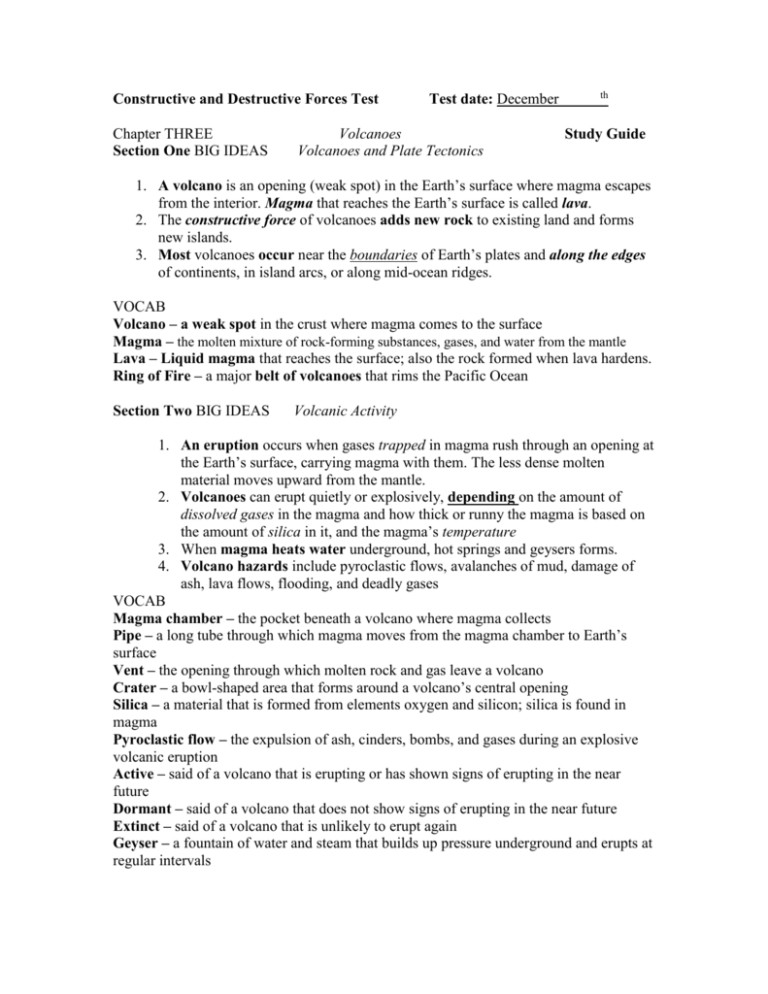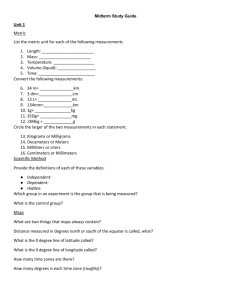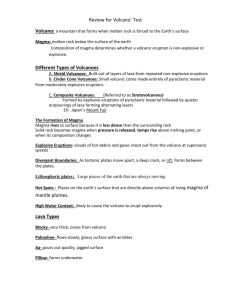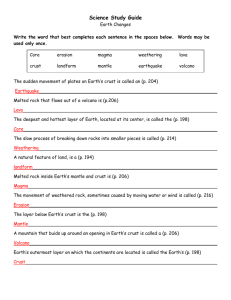Study guide for constructive and destructive forces
advertisement

Constructive and Destructive Forces Test Chapter THREE Section One BIG IDEAS Test date: December Volcanoes Volcanoes and Plate Tectonics th Study Guide 1. A volcano is an opening (weak spot) in the Earth’s surface where magma escapes from the interior. Magma that reaches the Earth’s surface is called lava. 2. The constructive force of volcanoes adds new rock to existing land and forms new islands. 3. Most volcanoes occur near the boundaries of Earth’s plates and along the edges of continents, in island arcs, or along mid-ocean ridges. VOCAB Volcano – a weak spot in the crust where magma comes to the surface Magma – the molten mixture of rock-forming substances, gases, and water from the mantle Lava – Liquid magma that reaches the surface; also the rock formed when lava hardens. Ring of Fire – a major belt of volcanoes that rims the Pacific Ocean Section Two BIG IDEAS Volcanic Activity 1. An eruption occurs when gases trapped in magma rush through an opening at the Earth’s surface, carrying magma with them. The less dense molten material moves upward from the mantle. 2. Volcanoes can erupt quietly or explosively, depending on the amount of dissolved gases in the magma and how thick or runny the magma is based on the amount of silica in it, and the magma’s temperature 3. When magma heats water underground, hot springs and geysers forms. 4. Volcano hazards include pyroclastic flows, avalanches of mud, damage of ash, lava flows, flooding, and deadly gases VOCAB Magma chamber – the pocket beneath a volcano where magma collects Pipe – a long tube through which magma moves from the magma chamber to Earth’s surface Vent – the opening through which molten rock and gas leave a volcano Crater – a bowl-shaped area that forms around a volcano’s central opening Silica – a material that is formed from elements oxygen and silicon; silica is found in magma Pyroclastic flow – the expulsion of ash, cinders, bombs, and gases during an explosive volcanic eruption Active – said of a volcano that is erupting or has shown signs of erupting in the near future Dormant – said of a volcano that does not show signs of erupting in the near future Extinct – said of a volcano that is unlikely to erupt again Geyser – a fountain of water and steam that builds up pressure underground and erupts at regular intervals Section Three BIG IDEAS Volcanic Landforms 1. Lava and other volcanic materials on the surface create shield volcanoes, cinder cones, composite volcanoes, and plateaus. 2. Magma that hardens beneath the surface creates batholiths, dome mountains, dikes, and sills, which are eventually exposed when the covering rock wears away. VOCAB Shield volcano – a wide, gently sloping mountain made of layers of lava and formed by quiet eruptions Cinder cone – a steep, cone-shaped hill or mountain made of volcanic ash, cinders, and bombs piled up around the volcano’s opening Composite volcano – a tall, cone-shaped mountain in which layers of lava alternate with layers of ash and other volcanic materials; most explosive Caldera – the large hole at the top of the volcano formed when the roof of a volcano’s magma chamber collapses Volcanic neck –a deposit of hardened magma in a volcano’s pipe exposed after the surface erodes away Chapter Two Section One BIG IDEAS Earthquakes Earth’s Crust in Motion 1. Stresses on Earth’s surface show compression, tension, and shearing on rock. 2. Faults are cracks in Earth’s crust that result from stress. 3. Faulting and folding of the crust cause mountains and other features to form on the Earth’s surface. VOCAB Earthquakes- the shaking that results from the movement of rock beneath Earth’s surface Fault- a break in Earth’s crust where slabs of rock slip past each other Strike-slip fault - a type of fault where rocks on either side move past each other sideways with little up-or-down motion Normal fault – a type of fault where the hanging wall slides downward; caused by tension in the crust Reverse fault –a type of fault where the hanging wall slides upward caused by compression in the crust Fault-block Mountain – a mountain that forms where a normal fault uplifts a block of rock Fold- a bend in rock that forms where part of Earth’s crust is compressed Anticline – an upward fold in rock formed by compression of Earth’s crust Syncline- a downward fold in rock formed by compression in Earth’s crust Plateau- a large area of flat land, elevated high above sea level Section Two BIG IDEAS Measuring Earthquakes 1. As seismic waves travel through Earth, they carry the energy of an earthquake from the focus to the surface 2. Earthquakes produce two types of waves, P waves and S waves, which travel out in all directions from the focus of the earthquake. 3. Today, the Moment Magnitude scale is used to determine the magnitude of an earthquake. Other scales that geologists have used to rate earthquakes include the Mercalli scale and the Richter scale. VOCAB Focus – the point beneath Earth’s surface where rock breaks under stress and causes an earthquake Epicenter - the point on Earth’s surface directly above an earthquake’s focus. Seismic waves- a vibration that travels through Earth carrying the energy released during an earthquake P waves – a type of seismic wave that compresses and expands the ground S waves – a type of seismic wave that moves the ground up and down and side to side Seismograph – a device that records ground movements caused by seismic waves as they move through Earth Richter scale- a scale that rates seismic waves as measured by a particular type of mechanical seismograph Moment magnitude scale – a scale that rates earthquakes by estimating the total energy released by an earthquake BIG IDEAS Weathering, Erosion, and Deposition 1. There are three types of weathering: biological, mechanical (AKA physical) and chemical 2. Mechanical weathering is the breaking down of rocks into smaller pieces. The change in the rock is physical with little or no chemical change. Examples of mechanical weathering are freezing/thawing, abrasion (wind/water/friction), and pressure releases (gases given off). 3. Chemical weathering is the decomposition of rock from exposure to water and/or atmospheric gases (principally carbon dioxide, oxygen, and water vapor). As rock is decomposed, new chemical compounds form. Examples of chemical weathering are rusting, acid breakdown from plants, and solution weathering (copper turns green), acid rain. 4. Biological Weathering is the action of living things on the solid surface of the Earth. Lichen breaking down rock is one example. 5. Erosion is the picking up or physical removal of rock particles by an agent such as a stream or glacier. Weathering helps to break down or erode material such as rock or soil. Most rock particles are partially weathered, but rock can be eroded before it has weathered at all. VOCAB Weathering- the process of breaking down of rocks and other materials on the Earth’s surface Erosion – process by which rock, sand, and soil are broken down and carried away Deposition – process in which sediment is laid down in new locations LEQ: “How do constructive forces build up Earth’s surface while destructive forces wear away the Earth’s surface? Example response: Constructive forces that build up the Earth’s surface such as volcanoes and deposits of sediment, sand, and ice can create land, sand dunes, and carve out lakes through glaciers. These forces can help raise the elevation of a land area. Destructive forces that wear away the Earth’s surface such as weathering and erosion, earthquakes, tsunamis, as well as flash floods will break down the Earth’s surface in places. Sometimes events like volcanoes can be both destructive and constructive by the spreading of new molten material on surfaces. That same volcano can contribute to erosion by destroying trees and other plants allowing the surface to be torn away.







